You'll find seven time-tested methods to create delicious brandy-soaked fruit. Try the basic one-day soak for quick results, or opt for traditional overnight marination for richer flavors. The sugar-first maceration method draws out natural juices before adding brandy, while stewed fruit preservation creates tender, boozy treats. For long-term storage, keep fruit submerged in brandy for months or even years. The mixed fruit brandy blend combines various berries with spices, and the simple syrup method guarantees perfectly balanced sweetness. Each technique offers unique characteristics that'll transform your culinary creations.
Basic One-Day Brandy Soak
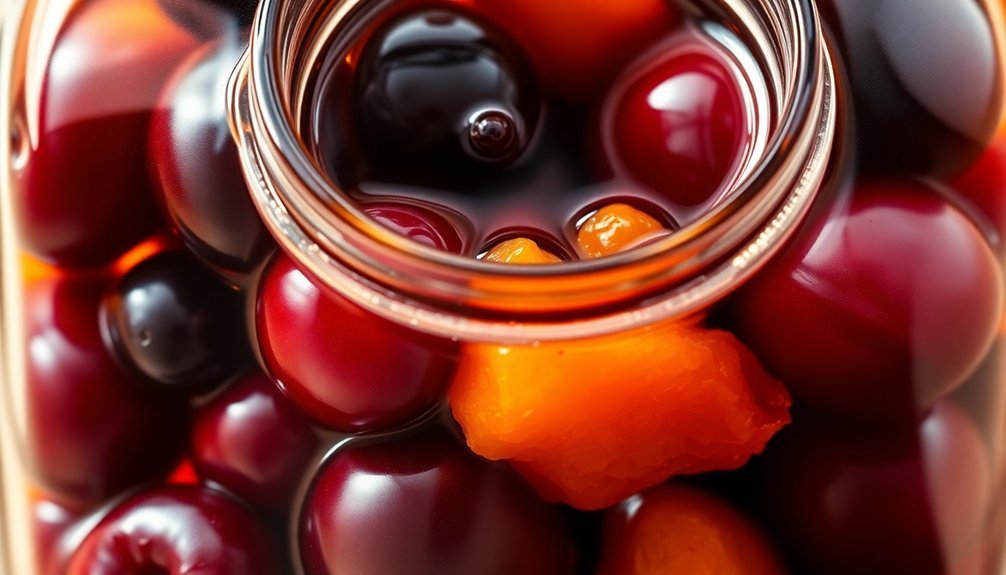
With just 24 hours of soaking time, you'll transform fresh fruits into boozy treats perfect for desserts and baking. Start by selecting fresh, ripe berries – blueberries and strawberries work exceptionally well – and check carefully for any signs of mold or soft spots. For best results, divide your portions into 1/3 cup blueberries and 1 cup quartered strawberries.
Create your syrup by combining 3 tablespoons of sugar, 1/3 cup water, 1 teaspoon vanilla extract, 1/2 teaspoon cinnamon, and 1/4 teaspoon allspice in a saucepan. Heat the mixture over medium heat until it reaches a slight boil, stirring until the sugar dissolves completely.
Remove from heat and let it cool to room temperature.
Once your syrup has cooled, mix it with 2 cups of brandy. Place your selected fruits in clean jars, then pour the brandy-syrup mixture over them, making certain all the fruit is submerged. Seal the jars tightly and give them a gentle stir to distribute the liquid evenly.
Store your jars in a cool, dark place or refrigerate them for the 24-hour soaking period. Remember to shake the jars occasionally to guarantee even distribution of the brandy mixture.
You can use the soaked fruit for dessert toppings or baking, and don't forget to save the flavored brandy syrup for cocktails.
Traditional Overnight Fruit Marination
Steeped in tradition, overnight fruit marination offers a deeper flavor profile than quick soaking methods. You'll need to start by selecting and preparing your fruits, chopping them into uniform 1 cm pieces, and ensuring they're clean and dry before the soaking process begins. This preservation method helps maintain Caribbean culinary heritage while creating delicious treats.
For the best results, you'll want to select an appropriate container and soaking liquid. Use a glass jar with an airtight lid, avoiding plastic or metal containers that might react with the ingredients. Pour your chosen liquid, whether it's brandy, rum, or a non-alcoholic alternative like grape juice, until it completely covers the fruit.
Essential steps for successful overnight marination:
- Choose clean, dry fruits and chop them uniformly
- Use an airtight glass container with a proper seal
- Cover fruits completely with your chosen liquid
- Shake the container every 2-3 days for even soaking
- Monitor liquid levels and add more if needed
Once marinated, you can use your soaked fruits immediately or store them for later use. If you've used non-alcoholic liquids, keep the mixture refrigerated for up to three months.
Remember to stir the fruits regularly to keep the top layer moist and maintain quality.
Sugar-First Maceration Method
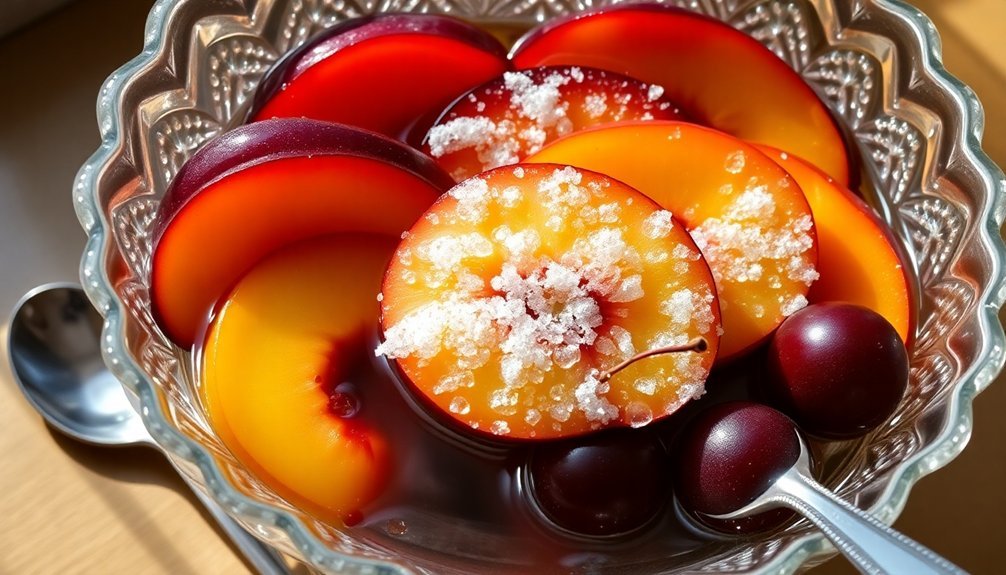
Start your fruit preparation by layering sugar between thin slices of your chosen fruit in a non-reactive bowl, as this initial sugar coating helps draw out the fruit's natural juices.
You'll want to guarantee each layer of fruit is dusted with sugar, creating alternating levels that maximize the extraction process. This technique works with both fresh and dried fruits.
Once you've completed the layering, you'll notice the sugar beginning to dissolve as it pulls moisture from the fruit, creating the foundation for a rich syrup.
Sugar Draws Natural Juices
The sugar-first maceration method draws out the natural juices from your fruit before introducing the brandy. When you sprinkle sugar over your freshly prepared fruit, it starts a process called osmosis, where the sugar pulls moisture from the fruit's cells, creating a flavorful syrup. For ideal results, you'll want to use about 50 grams of sugar for every 300 grams of fruit.
Before adding any brandy, make sure you've:
- Washed and thoroughly dried your fruit
- Removed all stems and unwanted parts
- Cut the fruit into consistent, bite-sized pieces
- Applied sugar evenly across all surfaces
- Covered the bowl with plastic wrap or a lid
Let your sugared fruit rest for 30 minutes to an hour, allowing the natural juices to accumulate in the bottom of your bowl. You'll notice the fruit becoming slightly softer and glossier as the sugar does its work.
This pre-brandy maceration step is essential because it helps the fruit absorb the alcohol more effectively once you add it. The resulting syrup will blend perfectly with the brandy, creating a more balanced and flavorful final product.
Layering Sugar Between Fruits
Layer-by-layer assembly proves vital when creating perfectly macerated fruit with sugar.
You'll want to start with a clean, large jar or container, placing a thin layer of sugar at the bottom. Add your prepared fruit in a single layer, making certain you've removed any blemishes or soft spots beforehand. Cover this first fruit layer completely with sugar, using approximately 2-3 cups total for your entire batch.
Continue this layering process, alternating between fruit and sugar until you've used all your prepared fruit. As you build these layers, make certain each fruit layer is thoroughly coated with sugar – this even distribution is vital for proper maceration.
Don't skimp on the sugar between layers, as it's important for drawing out the fruit's natural juices.
Once you've completed the layering, let your mixture sit at room temperature for about 30 minutes to initiate the maceration process. You'll notice the sugar beginning to dissolve as it pulls moisture from the fruit.
After this initial period, transfer your container to the refrigerator, but remember to shake it periodically to help distribute the dissolving sugar and continuing juices throughout the mixture.
Stewed Fruit Preservation
You'll want to begin your stewed fruit preservation by simmering your chosen fruits in a sugar syrup until they reach a tender consistency while maintaining their shape.
The traditional ratio calls for equal parts sugar to water, though you can adjust this to suit your taste and preservation needs.
For best results, you should maintain a gentle simmer throughout the cooking process, as rapid boiling can break down the fruit's structure and compromise the final texture.
Traditional Stewing Methods
Preserving stewed fruit requires careful attention to sterilization and proper sealing techniques. You'll need to start by sterilizing your jars and lids in boiling water or using your dishwasher's hot cycle. When handling hot jars, always use oven gloves to maintain sterility and prevent burns.
For traditional stewing methods, follow these essential steps:
- Wash and prepare your fruit by peeling and chopping as needed
- Fill sterilized jars with hot stewed fruit using a clean funnel
- Remove air bubbles with a chopstick or similar tool
- Leave approximately 1-1.5cm headspace at the top
- Wipe jar rims with a clean, damp cloth before sealing
Once you've filled the jars, screw on the lids firmly but not too tightly, allowing for expansion during processing.
You'll want to process your jars using either the water bath or open pan method. For water bath processing, submerge the jars in cold water, bring to a boil, and maintain for 30-60 minutes.
After processing, monitor the jars for 48 hours to verify proper sealing. Store your properly sealed jars in a cool, dark place, and don't forget to label and date them for easy tracking.
Heat and Sugar Ratios
When creating brandy-soaked fruit, proper heat application and sugar ratios are essential for successful preservation. You'll need to start by bringing your sugar, water, and spices to a gentle boil, then allow the mixture to cool before adding the brandy. This cooling period prevents immediate fermentation and guarantees even flavor distribution.
For ideal preservation, you'll want to maintain a sugar concentration of around 60%, though it can go up to 70-72%. The ideal ratio is 60% fruit to 40% sugar by weight, which provides enough sweetness while maintaining the fruit's natural flavors.
| Process Step | Temperature | Duration |
|---|---|---|
| Initial Boil | Gentle boil | Until sugar dissolves |
| Cooling | Room temp | Until completely cool |
| Maceration | No heat | 1 hour |
| Syrup Mix | Room temp | Until combined |
| Storage | Cool, dark | 1+ months |
After combining your fruit and sugars, let them macerate for an hour without heat. This process releases the fruit's natural juices. There's no need for water-bath processing, as the brandy acts as a preservative. Your fruit will continue to develop flavor over time, with ideal results after at least one month of storage.
Long-Term Storage Technique
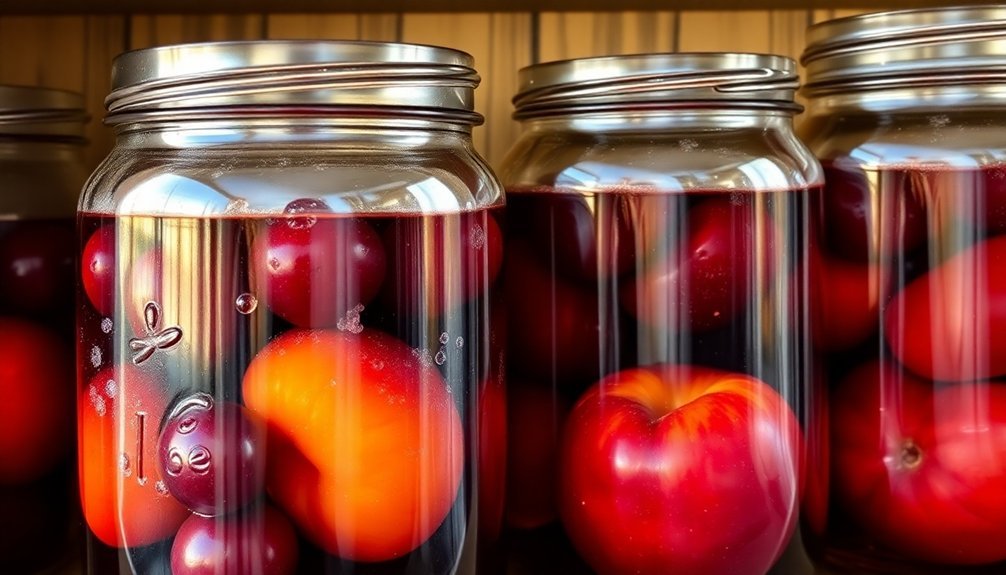
Successful long-term storage of brandy-soaked fruit begins with proper preparation and careful attention to detail. Start by washing and thoroughly drying your fruit, removing any damaged pieces that could lead to spoilage. Pack the fruit tightly into clean glass jars and make certain it's completely submerged in brandy to prevent air exposure.
Your initial storage phase is essential for developing proper flavor infusion. Place the jars in a dark cupboard and follow these vital maintenance steps:
- Shake the jars gently every few days for even infusion
- Monitor for any signs of spoilage or mold
- Keep jars away from heat and direct sunlight
- Top up with brandy if fruit becomes exposed
- Allow mixture to steep for 3-4 weeks before refrigeration
After the initial steeping period, transfer your jars to the refrigerator for long-term storage.
You'll find that properly stored brandy-soaked fruit can last anywhere from three months to a year, with some mixtures lasting up to 15 years when maintained correctly.
Remember to check periodically for signs of spoilage and maintain proper alcohol levels, as this acts as your primary preservative.
Mixed Fruit Brandy Blend
Creating a mixed fruit brandy blend offers endless possibilities for combining seasonal fruits into a delightful infusion. You'll want to start with ripe blackberries, strawberries, and blueberries, combining them with granulated sugar and a mid-priced brandy. For added complexity, you can incorporate vanilla extract, cinnamon, or allspice.
| Component | Basic Blend | Premium Blend |
|---|---|---|
| Base Spirit | Mid-priced brandy | Aged cognac or armagnac |
| Fruit Mix | Blackberries, strawberries | Add blueberries, raspberries |
| Enhancers | Sugar only | Sugar plus spices |
Begin by muddling your chosen fruits with sugar to release their natural juices. Pour your brandy over this mixture, ensuring the sugar dissolves completely. Transfer everything to a clean jar and store it in a cool, dark place. You'll need to shake the jar vigorously every other day for the first three weeks, then weekly afterward.
After at least three weeks of infusion, strain the mixture through a sieve. You can use the brandy-soaked fruit in desserts or as toppings, while the liquid makes an excellent base for cocktails or can be enjoyed on its own over ice.
Simple Syrup Soaking Method
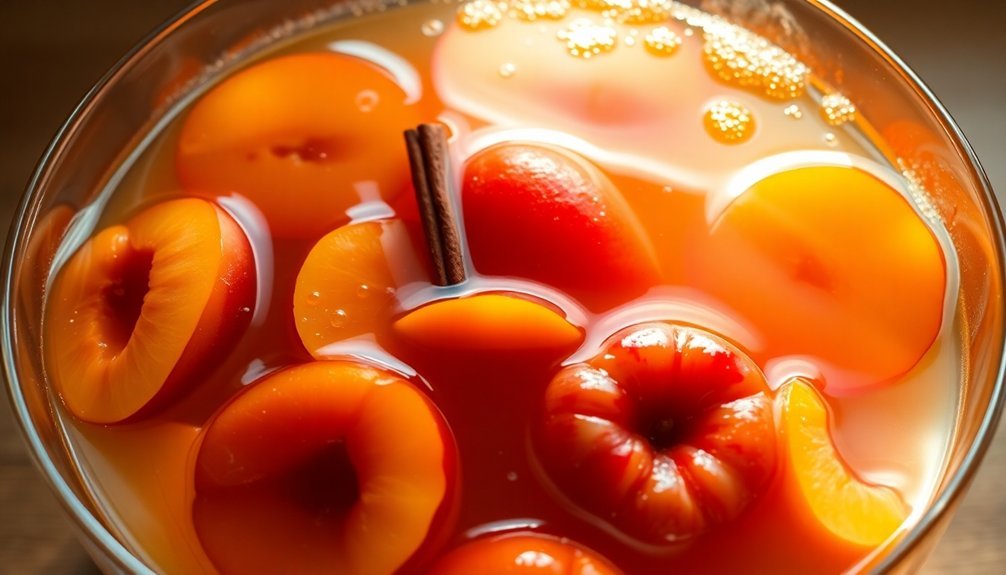
Before diving into the brandy-soaking process, you'll need to prepare a flavorful simple syrup base that transforms ordinary fruit into a delectable treat. Start by combining sugar and water in a saucepan, bringing the mixture to a gentle simmer while stirring until the sugar dissolves completely.
To create a richly spiced syrup, you'll want to add these essential elements:
- Fresh ginger root for a warm, zesty kick
- Whole cloves for deep, aromatic notes
- Cinnamon sticks for sweet warmth
- Bay leaves for subtle complexity
- Vanilla extract for smooth, rounded flavor
Once your spices are added, let the syrup cool slightly before incorporating it into your fruit preparation. You'll know it's ready when it's still warm but not hot enough to cook the fruit.
If you're working with firmer fruits like apples or pears, you may need to briefly stew them in the syrup until they're just tender.
Pour your cooled syrup mixture over the fruit in sterilized jars, then add your brandy. Make sure to seal the jars tightly and give them a gentle shake to distribute the flavors evenly throughout the mixture.
Frequently Asked Questions
Can You Use Plastic Containers Instead of Glass Jars for Soaking Fruit?
You can use food-grade plastic containers instead of glass jars for soaking fruit, but you'll need to guarantee they're airtight and won't degrade. Glass is still preferred for better flavor preservation.
What Happens if You Accidentally Add Too Much Brandy?
If you've added too much brandy, your cake might become overly moist and soggy. You'll notice overpowering alcohol flavors that mask other ingredients. Consider draining excess liquid or adding more dry ingredients to rebalance.
Does the Alcohol Content Remain After Baking the Soaked Fruits?
You'll find that baked soaked fruits still retain alcohol, though the amount varies. Even after 2 hours of baking, 10% remains. If you've used bread toppings, you'll keep even more alcohol content.
Can Frozen Fruits Be Used Instead of Dried Fruits?
While you can use frozen fruits, they're not ideal replacements for dried fruits. You'll face texture issues and excess moisture problems. They won't absorb brandy as effectively, and your final result may be too soft.
Is It Safe to Give Brandy-Soaked Fruit Desserts to Children?
You shouldn't serve brandy-soaked fruit desserts to children, as they aren't baked and retain high alcohol content. If you're serving kids, it's best to use alcohol-free alternatives or traditional baked desserts instead.
In Summary
You'll find these seven brandy-soaking methods offer endless possibilities for your culinary adventures. Whether you're making a quick one-day soak or planning months ahead, each technique brings unique flavors and textures to your fruit. Try combining different methods to create your own signature preserved fruits. Remember to store your creations properly, and you'll always have delicious brandy-infused fruit ready for desserts, cocktails, or snacking.

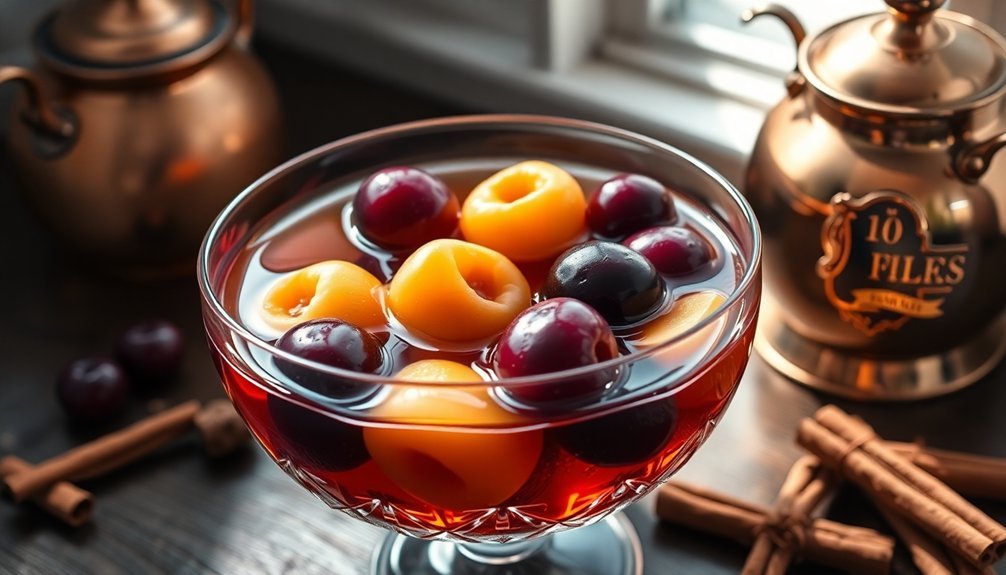



Leave a Reply